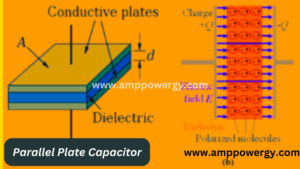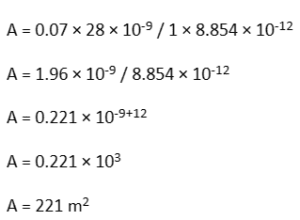What is a Parallel Plate capacitors
Overview
Capacitor is one of the important components like resistor and inductor in the circuit. It is a passive device which is available in many varieties. In this article we will dive in the depth of parallel plate capacitor.
What is a parallel plate capacitor?
Parallel plate capacitor is formed from the electrode and insulating materials or dielectric materials. Parallel plate capacitor store energy until the dielectric breakdown occurs, that as the storage of energy in parallel plate capacitor is finite.
The plates of the parallel plate capacitor have equal dimensions. These plates are connected to the battery. The plate which is connected to the positive terminal gain positive charges and the plate which is connected to the negative terminal gain negative charges.
When two plates in parallel connected to the battery. The plates of the capacitor charged, and electric field produced in them, and this phenomenon is called parallel plate capacitor.
Note:
What is a passive device:
Passive device: passive devices are very important devices in electronic circuits. Passive device store or dissipate electrical energy while active devices generate electrical energy. These devices don’t need power to operate. Common passive devices are resistors, capacitors, inductors and transformers.
Formula for parallel plate capacitors
The direction of electric field and the direction of positive test charge is same. Capacitance is the ability of the capacitor of strong energy. Each capacitor has its own capacitance value. The parallel plate capacitor consists of two plates which are made from metal and the dielectric is placed between them. The area between plates is A, which is separated from the distance d.
Formula of parallel plate capacitor is.
Derivation of the Parallel Plate Capacitor
Expression for the capacitance of parallel plate capacitor
Consider there are two plates placed parallel to each other and these plates are separated by the distance d and the cross-sectional area is A.
Electric field by a single plate is.
Total electric field will be.
or
or
Potential difference between the plates will be.
V = Ed
Capacitance will be
Thus, the capacitance of the parallel plate capacitor will be.

Principal of Parallel Plate Capacitor
A certain amount of charge can be given to the plates. If more charge is supplied to the plates, then the potential difference will increase, and it can create a leakage in the charges. Now if another plate is placed near the positive charge plate, then the negative charge will flow towards these newly placed plates which are near the positive charge plate.
Now both plates have charges so the potential difference on plate 1 will decrease due to the negative charges on plate 2 while the potential difference will increase on plate 1 due to the positive charges on plate 2. but the impact of plate 2 will be more because of negative charges on plate 2 and due to these negative charges on plate 2 the potential difference will be less.
Read Also
Application of Parallel Plate Capacitors
There are different uses of capacitor in different places.
- Uses in filtering: parallel plate capacitor is used in a circuit to remove unwanted signals or unwanted noises from the electrical signals. For example, it can be used to remove the fluctuation from voltage in power signals. It is also used to block direct current and pass alternating current.
- Uses in tunning: it is also used to tune electrical signals for example it is used in radios, television.
- Uses in sensing: it is also used as a sensor for example it can sense pressure, temperature, displacement etc.
- Storing energy: parallel plate capacitor is also used to store electrical energy in the form of electric field. That is it can be used in flashlight, cameras etc. Equation for energy storing in parallel plate capacitor is.
Here U is energy stored express in joules (J), C is the capacitance in farads (F) and V is voltage.
Read Also:
Charge Stored in a Parallel Plate Capacitors
The amount of charge stored in the capacitor is directly proportional to the potential difference of the two plates.
Mathematically it can be represented is.
Q α V
Therefore
Q = CV
Here C express the capacitance.
Read Also
Importance of parallel plate capacitor
- Discharge and energy storage: parallel plate capacitors play a very important role in the storing of energy. When voltage is applied, they store energy in the form of an electric field between the plates. This energy discharge when needed which makes the capacitor important in various application.
- Tunning and filtering: it is also used in circuits for filtering that’s to stop or pass frequencies. They also used to smoot voltage to remove ripples.
- Measurment in sensing: capacitors are used in sensing and measurement equipment.
- Pressure sensor: it is also used in pressure sensor. Capacitors change its capacitance according to pressure.
- Humidity sensor: it is also used to measure humidity, that’s its capacitance change with humidity.
- Proximity sensor: it is also used to enable proximity sensor because the capacitance is changed when objects come across it.
- Energy efficiency: the internal resistance is low of parallel plate capacitor its means it can store and release energy.
- Compact design: the design in manufacturing of parallel plate capacitor is very easy and the compact design of these capacitor makes essential in very useful application
NOTE:
Brief Definition of Pressure:is the physical force on the object. The force which is applied on the object is perpendicular to the surface of the object. The unit of pressure is pascals (Pa), and its types are absolute pressure, atmospheric pressure, differential pressure, gauge pressure.
Brief Definition of Humidity: it represents the level of vapor in the air. The vapor is the gaseous state of water. Its level depends upon the temperature and pressure of the system. Types of humidity are absolute humidity, relative humidity, specific humidity.
There are some advantage and disadvantage of parallel plates capacitor.
Advantage of the Parallel Plate Capacitor
- High capacitance: because of the design parallel plate capacitor have high capacitance value. The capacitance of the parallel plate capacitor is proportional to the aera of the plates and inversely proportional to the distance between them.
- Simple construction: it is simple to construct a parallel plate capacitor. It consists of dielectric materials which is in between of two plates and two parallel plates which is made from the metals therefore it is called metal plates.
- Uniform electric field: the uniform between the plates is uniform which make the calculation and analysis easy.
- Widely used: it is used in different electronic circuits, which include filters and coupling of capacitors.
Disadvantage of the Parallel Plate Capacitor
- Limited energy storage: parallel plate capacitor can store limited amount of electric charge till breakdown occurs. Breakdown limit the energy storage in parallel plate capacitor.
- Dielectric losses: there are some losses in dielectric in real life which limit the efficiency of the capacitor. This loss is due to imperfection or faults.
- Size constraints: its size is low therefore its capacitance I low to achieve high capacitance the size of the plates should be large which makes the capacitor bulky and cannot use in the electronic circuits.
- Voltage sensitivity: its capacitance depends upon the applied voltage. When change comes in the voltage it directly affects the stored charge in the capacitor.
To summarize it, parallel plate capacitors offer high capacitance, but it is limited because of the applied voltage and dielectric materials. Electronic engineers carefully consider these points when they are going to design electronics circuit.
Example on Parallel Plate Capacitors
When a parallel plate capacitor kept in the air has an area of 0.60m square and separated by the distance of 0.06m. find the parallel plate capacitor.
Solution:
Given Data.
Area A = 0.5m2,
Distance d = 0.04m,
Relative permittivity k = 1,
Example 2
Find the area of parallel plate capacitor in the air if the capacitance is 28 nF and the distance between the plate is 0.07m/
Solution
Given data:
Capacitance = 28 nF
Distance = 0.07 m
Relative permittivity K = 1
Formula for parallel plate capacitor is.

(about 725.07 ft) (area between the plates).
Frequently asked question FAQs
Q1: What is capacitor?
Ans: capacitor is a passive component which is used to store energy in the form of electric field.
Q2: what is capacitance?
Ans: capacitance is the ability of the capacitor to store electric charge in electric field.
Q3: what is the unit of capacitance?
Ans: capacitance is measured in the subunits that is micro farad, Pico farad.
Q4: which energy store in a capacitor?
Ans: electrical potential energy is stored in the capacitor.
Q5: What is parallel plate capacitor?
Ans: it is a device which stores energy in the form of an electric field between two metal plates. The capacitance is directly proportional to the aera and inversely proportional to the distance between the plates.
Q6: How to calculate the capacitance of the parallel plate capacitor?
Ans: the capacitance of the parallel plate capacitor is calculated from this equation C = K / epsilon not.
Q7: Is the length of the two plates equal in size?
Ans: yes, the size of the two plates of parallel plate capacitor is equal in length.
Q8: Is mica a conducting material?
Ans: no mica is not a conducting material.
Q9: What is the unit of capacitance?
Ans: the unit of capacitance is Farad (F).
See Also:

